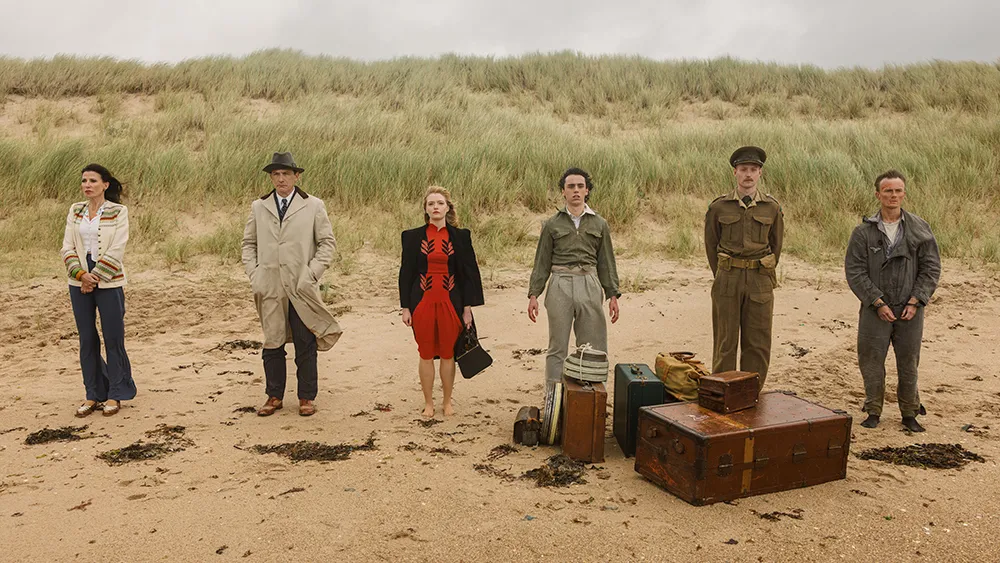Copyright Variety

Bowing in Tallinn’s official competition, “Think of England” is the long-awaited sophomore pic of BAFTA-nominated British writer-director Richard Hawkins. If his directorial debut “Everything” (2004) was billed by Variety as a “forcefully executed, slow-burning thriller….a “no-frills, nine-day production,” his new endeavour is another tour-de-force. A thought-provoking exploration of truth and deceit, moral boundaries, a nod to acting, through a character-driven WW2 porn satire. All of it wrapped in 21 days, with on-screen production value squeezed to its upmost by seasoned producer Nick O’Hagan (“The Serpent Queen,” “The Good Liar”) and Poppy O’Hagan of Giant Films. “It takes a lunatic to make a film and I’m quite a good one! I realized how comfortable I am with making movies and how I love it,” Hawkins quips, commenting about his 11-year hiatus since his breakthrough pic “Everything” starring Ray Winstone, that segued from his acclaimed screenwriting debut “The Theory of Flight,” helmed by Paul Greengrass. “Yeah, I was for a while disheartened by the film biz that can drag you down if you don’t watch it, as you get a lot more rejection than you’ll get successes,” he tells Variety. “I wanted to do other silly crazy stuff, live in different places. But then I felt it was unfinished business with film.” After nearly two decades of stalling with the script and another project with Giant Films in the making – “The Most Dangerous Girl in the World” – Hawkins finally cracked it. “I couldn’t make it work the way I felt was right. It just didn’t feel relevant to today’s times, but now it does. I wanted to explore the fine lines that we draw in the sand to define our moral compass. What is right and what is wrong, how those lines get very quickly washed away and re-written, notably during war,” Hawkins explains. The WWII satire is set in the run-up to the Allied invasion of France, when two British film projects are commissioned at the very highest level. One of them is a Laurence Olivier adaptation of Shakespeare’s “Henry V.” As the logline runs, “this is the story of the other project.” We follow a group of disparate souls, sent to the remote Orkney Island off the northeastern coast of Scotland. Their mission: to make propaganda porn movies to up the moral of the British boys on the frontline. The group is made up of a seriously damaged former movie star, a celebrated German director, a munitions-machinist-come-aspiring-actress, an Etonian major from the Ministry of Information; an aging hair-and-makeup artist and her son. Another person is on the island, watching. But when it’s time for the camera to roll, nothing goes as anticipated as tension creeps up, as does violence and the pressure of abiding to the contract of making porn. “Nothing chronicles the history of our moral structures more than film,” argues Hawkins, who cites some of the most iconic steamy scenes in film history: Hedy Lamarr walking naked in the woods in the 1933 “Ecstasy” and Burt Lancaster properly kissing Deborah Kerr on the beach in the 1953 “From Here to Eternity.” “U.S. politicians who were afraid that film would undermine the morality of society of the time, created the Hollywood Hays Code, but then WWII put an end to it.” “Yet two film taboos remain,” Hawkins continues, “and this is perhaps the epicentre of the movie. “There are two things you cannot act: actually having sex and killing someone. These lines can never be crossed in the real world. They have consequences.” As they have in “Think of England.” On that point, Hawkins said his pic is also a nod to actors, the psychological, emotional, even physical pressure that comes with their craft, especially when they have to perform “uncomfortable” scenes. “With actors, we sometimes don’t consider what they go through in the act of pretending. There’s a huge emotional turmoil going on that fascinates me,” he admits. Pushing further his reflection on reality and make belief, Hawkins also plays with the audience and our perception of truth in “Think of England” (plot twists are not disclosed here). “We’re in a world of fake news, authoritarianism creeping up; we’re starting to echo the mid-late 1930s with a threat to democracy. Before war comes propaganda and lies. In that sense, the film resonates with today’s reality. I wanted the film to be a reminder not to accept what we’re hearing,” insists the director. To make the film, Hawkins relied on an ensemble cast including Jack Bandeira (“Happy Valley,” “Lockwood & Co”), Natalie Quarry (“Call The Midwife“) in the title roles, John McCrea (“Cruella”), Ronni Ancona (“Big Impression”), Ben Bela Böhm (“Angels & Demons”), Ollie Maddigan (“The Olive Boy”) and Oscar Hoppe (“Munich: The Edge of War”). “Our idea was to cast people that would just walk on set and be in 1943, but not A-list names that would undermine the kind of double identity that everybody has in the film.” An intimacy coordinator was on set to help the actors feel safe and comfortable with the nudity and choreography of the sex scenes. “You could argue that this film goes back to the invention of intimacy coordination. We see the actress Holly Spurring spending a lot of time discussing with the director how she feels about being naked and having sex. Today, you have the intimacy coordinator filling that role, which is great as it’s an uncomfortable position for any director to have,” Hawkins observes. Shot in 21 days on a shoestring budget – partly in Shinfield Studios in Reading and on location on Anglesey in North Wales – the pic also benefitted from the expertise of cinematographer Sarah Cunningham (“The Banishing”), production designer Chris Richmond (“The Amazing Mr Blunden”), costume designer Nadia Dunn-Hill (“Wimbledon”) and hair & make-up Designer Alexis Arenas (“Tom Clancy’s Jack Ryan”). “We shot in color and black & white on a Mitchell Standard 35mm camera and with shifting aspect ratios to tell the multi-layered narrative,” adds Hawkins who said early pre-production work was crucial to set the visual style and priorities. Made in Cinema The O’Hagan father and daughter production duo said building trust with the cast and crew, making them feel “part of something unique” was quintessential. Nick O’Hagan underlined that his production model for indie filmmaking is built on collaboration and sharing, including financially, with the crew being offered “a small profit share of the box office.” Backed by private investors, the pic was executive produced by Geoffrey Freeman, Andrew Wood and Lucas Wood-Oliván. Domestic distribution and international sales are yet to be finalised. “We’re looking for true partners, willing to take part in the film’s journey on screens and guarantee the pic’s long-tail theatrical release,” Nick O’Hagan explains. As such, ”Think of England” is a blue print for the O’Hagan’s new Made for Cinema initiative, a movement “that supports and advocates for non-dependent filmmakers to get their work released theatrically across an extended window, connecting with audiences through events and stimulating conversations and community around provocative and ambitiously authored cinema,” says a statement, referring to a concept championed by indie production guru Ted Hope. “It’s about staying free from any constrains. This was the case with ‘Think of England’ and we will apply this vision for other filmmakers,” comments Nick O’Hagan.



